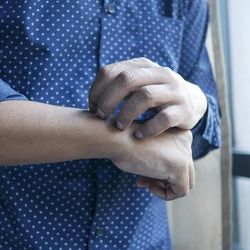An Expert Nurse Practitioner & Physician Assistant Exchange on the Management of Pediatric Atopic Dermatitis - Episode 3
Pediatric Atopic Dermatitis: Clinical Presentation
Experts in dermatology describe their clinical experiences of atopic dermatitis presentation in their patients, focusing on the heterogeneity across age groups and races.
Melodie Young, NP: Alexa, for a patient with atopic dermatitis, particularly pediatric—a toddler, an infant, an adolescent—these are different stages of childhood. How might that present in your clinic? What do you see that makes you say, “This is atopic dermatitis?”
Alexa Hetzel, MA, PA-C: By the time these patients come into our office, they’ve progressed enough where they’re severe. At infancy, it’s usually the common spots, the creases of the elbows and behind the knees. It’s not so much the patient. It’s the parent that’s frustrated at that point, because they can’t stop their kid from itching, and they don’t know what to do. As they get a little older, I have some patients in that 3- to 6-year-old population, and they’re just scratching themselves raw. That’s where I see the most infected patient, because they don’t understand what’s happening to them. The only way they can express themselves is by constantly scratching those excoriations. They’re miserable, and so are the parents. As we get into those adolescent teen years, they can express themselves a bit better and explain to their parents what’s going on. It really ebbs and flows there too. It’s mild in the beginning, severe at 3 to 6 years old, and then mild or ready to do something about it once they’re in their adolescent and teenage years.
Melodie Young, NP: Matthew, what do you see in the clinic? How does it present in the White population and the non-White population? Tell me what it looks like?
Matthew Brunner, PA: I see a lot of skin of color where I practice. Differentiating in the atopic patients who are skin of color, they were more likely to see a purple hue, a darker discoloration of the skin, depending on the age group. The prevalent part is that, over time, we’re seeing a pattern for these patients. It’s not a 1-off presentation. These patients are repeatedly coming back to the clinic. They usually have been to the pediatrician a number of times, and the moms and dads are very frustrated that their child isn’t getting better. One big part is talking about the chronicity of the disease, getting that expectation set for the parent, and helping the parents realize that they’re not doing anything wrong and they’re not feeding the child anything wrong. They’re not necessarily using something wrong in the care of the child’s skin. This is a disease. It’s an autoimmune disease, and it’s something we’re going to have to manage long term.
In White patients, although it may look a little different, they may have more visible erythema or scaling. They all can have hypopigmentation or hyperpigmentation—that more purple hue is what we’re going to see in skin of color. It takes a lot of repeated affirmation of the parents on follow-up visits, so you can do education on the first visit and send home handouts with the parents. Often you have to continue to reiterate and remind them on those follow-up visits because parents get frustrated with this.
One thing we haven’t touched on is the impact on the siblings. If siblings are sharing a room, you may have the atopic child up with a lot of sleep disturbance, which may further be impacting the sibling that’s sharing the room. There can also be sibling rivalry—maybe they perceive that the sibling who has atopic dermatitis is getting more attention from the parent. Or the parents may start to experience guilt that they’re spending so much time caring for 1 child over the other. They may also feel guilty because they skipped or missed applications. All that psychosocial comes into that counseling and helping the whole family unit become accustomed in understanding this. I try to relate it a lot to the family history, to find out who in the family may have an atopic history, talking to them about what their experience has been, and helping people see that this is not something they should feel guilty over. I help them accept that this may be more familial, and that there’s genetic inheritance here.
Melodie Young, NP: As clinicians, part of what we do is look at the patient, touch the skin, and listen to the parents. It’s not just the patient. It’s the entire family, the school nurse, and grandparents who must help with the children. Extra trips to the pharmacy, which may have special products—there are many things the parents have tried. Because about three-quarters of patients have mild disease. They could always have sneeze, wheeze, or rash, and sometimes all 3, which is the definition that you’re atopic. If you have 1 or 2 of those things, you expect that the other is going to show up.
Looking at the medication list, these patients have seen allergens and pediatricians. By the time they end up in the dermatologist’s office, often they’ve already been given standard topical corticosteroids—and all the over-the-counter lubrications that the primary care provider might know to do—by the time they see us. Then we start to see the itching. As Alexa mentioned, we see infections like impetigo and a lot of molluscum contagiosum in this population. There’s also a lot of conjunctivitis and eye infections associated with this. These patients spend a lot of time going to urgent care centers, because they haven’t put all the pieces together, nor have their families or caregivers. They haven’t understood the value of keeping the skin well controlled, not having these ups and downs and the misery, and the damage that occurs if you don’t get the atopic dermatitis controlled as a child. By the time they become an adult, as we’ve mentioned, the skin can be permanently damaged.
Transcript edited for clarity


